Sensor Sweep: Siege of the Black Citadel, Middle Earth RPG, World of Warcraft
Tuesday , 14, March 2023 Sensor Sweep Leave a commentWeird Tales (Tellers of Weird Tales): The first issue of Weird Tales, dated March 1923, probably arrived on newsstands before that, possibly in mid to late February. I base that only on the idea that magazines usually showed up ahead of their cover dates so as to avoid seeming outdated. For example, Time magazine also started in March 1923. Beginning as a weekly, the first issue was dated March 3. According to Wikipedia–which knows lots of true things but lots of untrue things, too–it was actually put out on February 24.
Sword & Sorcery (Vintage Pop Fiction): Renegade Swords is a sword-and-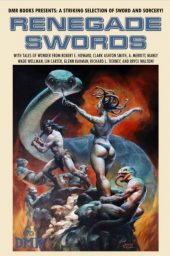 sorcery anthology from DMR Press and as usual they’ve come up with an interesting mix of stories. This is a fairly strong collection embracing both conventional sword-and-sorcery stories and stories that either fit into related genres or don’t fit neatly into any genre. Either way it’s highly recommended.
sorcery anthology from DMR Press and as usual they’ve come up with an interesting mix of stories. This is a fairly strong collection embracing both conventional sword-and-sorcery stories and stories that either fit into related genres or don’t fit neatly into any genre. Either way it’s highly recommended.
Firearms (Handwaving Freakoutery): It is taken as an obvious given by approximately half of the United States that we are in a massive epidemic of AR-15 homicides, and that something must be done about it. This given is not only completely false, the level of falseness of it is almost incomprehensible. Let’s try and understand exactly how false it is by using simple arithmetic.
Science Fiction (Euronews): 8 March 1978: The first chapter of The Hitchhiker’s Guide to the Galaxy
It was a quiet, late winter night for the British public when they tuned into BBC Radio 4 and entered the weird world and wonderful of Douglas Adams. On this day, the very first episode of English author Adams’ legendary series ‘The Hitchhiker’s Guide to the Galaxy’ was released.
Robert E. Howard (Sprague de Camp Fan): One notices a lot of POD (print on demand) books on Amazon these days. In regard to Robert E. Howard most of these books are PD (public domain) and anyone with the software can publish a Robert E. Howard book. Most are reprints of Weird Tales stories and will have the edits made by Farnsworth Wright.
on demand) books on Amazon these days. In regard to Robert E. Howard most of these books are PD (public domain) and anyone with the software can publish a Robert E. Howard book. Most are reprints of Weird Tales stories and will have the edits made by Farnsworth Wright.
 Robert E. Howard (REH World): Robert E. Howard was well-known for his affection for animals, demonstrating kindness towards stray cats, dogs, and even a starving horse. At the time of his passing, 13 stray cats frequently visited his residence. Tevis Clyde Smith, Robert’s closest friend, expanded upon his thoughts on animals in Pecan Valley Days:
Robert E. Howard (REH World): Robert E. Howard was well-known for his affection for animals, demonstrating kindness towards stray cats, dogs, and even a starving horse. At the time of his passing, 13 stray cats frequently visited his residence. Tevis Clyde Smith, Robert’s closest friend, expanded upon his thoughts on animals in Pecan Valley Days:
RPG (Busybody): This module is a long time coming: thirty-two years. Mark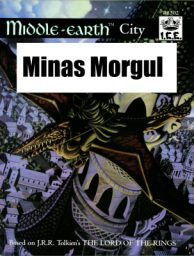 Rabuck did a great job with Minas Ithil (1991), but let’s face it, that wasn’t the module we were waiting for, and the Nazgul on the cover seemed to promise more. I’ve held out hopes that Other Minds would take on the task, but in its sixteen years of high-quality Middle-Earth output, those great minds have curiously steered clear of Minas Morgul.
Rabuck did a great job with Minas Ithil (1991), but let’s face it, that wasn’t the module we were waiting for, and the Nazgul on the cover seemed to promise more. I’ve held out hopes that Other Minds would take on the task, but in its sixteen years of high-quality Middle-Earth output, those great minds have curiously steered clear of Minas Morgul.
Pulp (Dark Worlds Quarterly): The Fantastic in the Argosy in the 1920s makes sense after looking at Argosy in the 1930s. If you missed the 1930s, go here. No surprise, we see many familiar names even ten years earlier: Abraham Merritt, Murray Leinster, Ray Cummings, Francis Stevens, and J. U. Giesy and Junius B. Smith with Semi-Dual (and not for the first time!) There are also a crew of writers who would leave before the next decade like Jack Bechdolt and L. Patrick Greene who would write for Adventure later, Paul L. Anderson shows up a lot, and Garret Smith who would become an Amazing Stories writer by default.
Conan (Paperback Warrior): The December, 1955 Fantastic Universe issue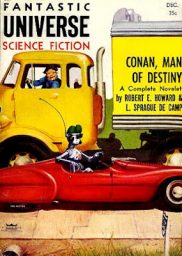 featured an L. Sprague de Camp Conan story called “Conan, Man of Destiny”. This story was taken from a Robert E. Howard manuscript, originally titled “The Road of the Eagles”, discovered by Glenn Lord, about the Ottoman Empire featuring a hero named Ivan Sablianka. Howard’s original version was edited by Lord and published in the Donald Grant collection Road of Azrael as “The Way of the Swords”.
featured an L. Sprague de Camp Conan story called “Conan, Man of Destiny”. This story was taken from a Robert E. Howard manuscript, originally titled “The Road of the Eagles”, discovered by Glenn Lord, about the Ottoman Empire featuring a hero named Ivan Sablianka. Howard’s original version was edited by Lord and published in the Donald Grant collection Road of Azrael as “The Way of the Swords”.
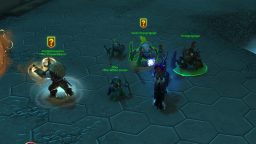 Gaming (DVS Press): World of Warcraft was never known for having exceptional writing, but the past versions of the game were quite sharp and effective, producing long-lasting memories of characters, places, and events, while newer expansions have produced a grey blur of forgettable babble from interchangeable blobs of characters. But why?
Gaming (DVS Press): World of Warcraft was never known for having exceptional writing, but the past versions of the game were quite sharp and effective, producing long-lasting memories of characters, places, and events, while newer expansions have produced a grey blur of forgettable babble from interchangeable blobs of characters. But why?
James Bond (Matt Walsh): The James Bond books have been tackled by “sensitivity readers” and are now being revised to be more acceptable to our new woke culture.
Authors (DMR Books): Peter Beresford Ellis—also known as ‘Peter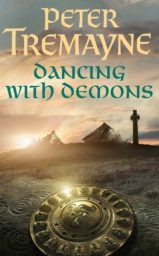 Tremayne’ and ‘Peter MacAlan’—was born on this date in 1943. Without a doubt, he is one of the foremost popularizers of Celtic fiction and non-fiction of the last hundred years. In addition, he has authored biographies of H. Rider Haggard and Talbot Mundy.
Tremayne’ and ‘Peter MacAlan’—was born on this date in 1943. Without a doubt, he is one of the foremost popularizers of Celtic fiction and non-fiction of the last hundred years. In addition, he has authored biographies of H. Rider Haggard and Talbot Mundy.
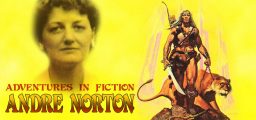 Authors (Goodman Games): Born as Alice Mary Norton in 1912, Norton started writing while she was still in high school in Cleveland, Ohio. In fact, she completed her first novel while still attending high school, though it was not published until later in 1938. Wishing to pursue writing as a career, in 1934 she had her name legally changed to Andre Alice Norton, and adopted several male-sounding pen names so as to prevent her gender from becoming an obstacle to sales in the first market she wrote for: young boys literature.
Authors (Goodman Games): Born as Alice Mary Norton in 1912, Norton started writing while she was still in high school in Cleveland, Ohio. In fact, she completed her first novel while still attending high school, though it was not published until later in 1938. Wishing to pursue writing as a career, in 1934 she had her name legally changed to Andre Alice Norton, and adopted several male-sounding pen names so as to prevent her gender from becoming an obstacle to sales in the first market she wrote for: young boys literature.
T.V. (Kairos): Most of this blog’s readers are probably unfamiliar with Get a Life. A vehicle for David Letterman alum Chris Elliott, this unconventional sitcom embodied the early 90s trend toward quirkiness, edginess, and the outright weird. If you want an idea of the Get a Life viewing experience, it came around back when the fledgling Fox Network was just finding its niche.
Life. A vehicle for David Letterman alum Chris Elliott, this unconventional sitcom embodied the early 90s trend toward quirkiness, edginess, and the outright weird. If you want an idea of the Get a Life viewing experience, it came around back when the fledgling Fox Network was just finding its niche.
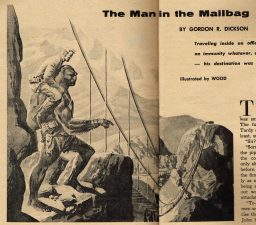 Art (Cap’n’s Comics): The Man in the Mailbag by Wally Wood
Art (Cap’n’s Comics): The Man in the Mailbag by Wally Wood
Comic Books (DMR Books): Doug Moench was born in Chicago on February 23, 1948. He grew up on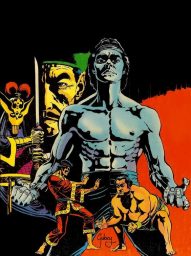 comics, especially horror comics. Thus, when he decided to leap beyond being a comics fan to becoming a pro in 1970, Warren Publishing was where he sent his initial stories. Legendary comics editor/writer, Archie Goodwin, bought all five tales and Moench was off n’ running.
comics, especially horror comics. Thus, when he decided to leap beyond being a comics fan to becoming a pro in 1970, Warren Publishing was where he sent his initial stories. Legendary comics editor/writer, Archie Goodwin, bought all five tales and Moench was off n’ running.
Heroes (Arkhaven Comics): The Barbarian can be hilariously problematic to define in the current year because modern intellectuals are terrified of offending the indigenous peoples they look down on. At the end of the day, the intelligentsia is trying to redefine something that they find secretly terrifying into something harmless. Something that they can saddle and use for their own purposes. There is nothing new in this. And in the end, it always works out about as well as civilizing Arminius did for the Romans.
Conan (Arkhaven Comics): This was where I first discovered the barbaric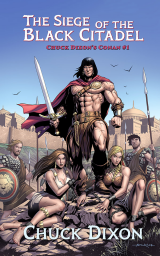 world of Conan the Cimmerian. A savage land that I dove into each month with every new issue (or at least as often as the new issues made it out to my corner of the boondocks. For a long time, Savage Sword was it for me. I didn’t start reading genuine Robert Howard until I got to college. It took some work back then to find authentic Howard. Back then the inferior pastiche works of L. Sprague De Camp predominated the market. In that pre-internet world, there were works of Howard that were considered lost media, fortunately, that has changed with time.
world of Conan the Cimmerian. A savage land that I dove into each month with every new issue (or at least as often as the new issues made it out to my corner of the boondocks. For a long time, Savage Sword was it for me. I didn’t start reading genuine Robert Howard until I got to college. It took some work back then to find authentic Howard. Back then the inferior pastiche works of L. Sprague De Camp predominated the market. In that pre-internet world, there were works of Howard that were considered lost media, fortunately, that has changed with time.
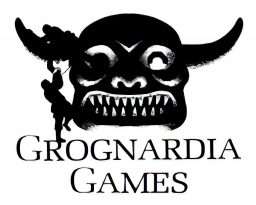 RPG (Geek Native): The winner of the Geek Native’s Patrons RPG Publisher Spotlight this month is Grognardia Games. Every month this group of hardcore site supporters get to vote on a shortlist (and suggest candidates) for a creator or publisher to get some extra attention. You’ll see winners called out in the RPG news summaries of Routinely Itemised, mentioned on the podcast and in a permanent home on the Spotlight page.
RPG (Geek Native): The winner of the Geek Native’s Patrons RPG Publisher Spotlight this month is Grognardia Games. Every month this group of hardcore site supporters get to vote on a shortlist (and suggest candidates) for a creator or publisher to get some extra attention. You’ll see winners called out in the RPG news summaries of Routinely Itemised, mentioned on the podcast and in a permanent home on the Spotlight page.
Fantasy (From the Sorcerers Skull): I’ve written before about the implied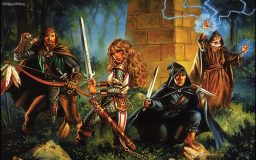 setting of 80s TSR art, but it’s really only a subcategory of more widespread trends in fantasy of the 80s. Obviously, with something as broad as a multimedia genre, it’s difficult to encompass all the works that appear in that time period with any sort of list of features, but I think the following elements are ways that the body of fantasy of the 80s tended to be different from what came before and to an extent, what came after.
setting of 80s TSR art, but it’s really only a subcategory of more widespread trends in fantasy of the 80s. Obviously, with something as broad as a multimedia genre, it’s difficult to encompass all the works that appear in that time period with any sort of list of features, but I think the following elements are ways that the body of fantasy of the 80s tended to be different from what came before and to an extent, what came after.
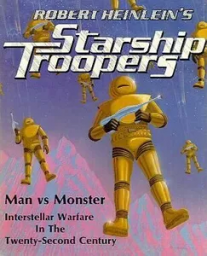 Games (Jeffro’s Space Gaming): When I first opened the box, I was delighted. The game is broken down into seven scenarios– and each scenario has its own rules section telling you ONLY what you need to know in order to run just that one in particular. The idea here was Avalon Hill’s “Programmed Instruction” method which would allow new players to learn just a little bit of the rules at a time.
Games (Jeffro’s Space Gaming): When I first opened the box, I was delighted. The game is broken down into seven scenarios– and each scenario has its own rules section telling you ONLY what you need to know in order to run just that one in particular. The idea here was Avalon Hill’s “Programmed Instruction” method which would allow new players to learn just a little bit of the rules at a time.
Science Fiction (Strange at Ecbatan): I mentioned recently that I am very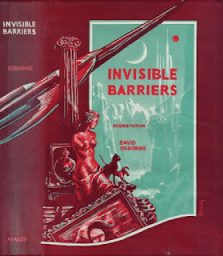 close to having read all of Robert Silverberg’s early novels — that is, the novels before his remarkable transformation, early in the 1960s, from a skilled but rather shallow, and very prolific, writer to a quite powerful and interesting writer (still prolific but less so than before.) There are two novels that are either unavailable (in the US) or too expensive used for my blood. These are Aliens from Space and Invisible Barriers. I had an idea for an end run around this problem — Silverberg very often published shorter versions of his novels as novellas in the many magazines of the period.
close to having read all of Robert Silverberg’s early novels — that is, the novels before his remarkable transformation, early in the 1960s, from a skilled but rather shallow, and very prolific, writer to a quite powerful and interesting writer (still prolific but less so than before.) There are two novels that are either unavailable (in the US) or too expensive used for my blood. These are Aliens from Space and Invisible Barriers. I had an idea for an end run around this problem — Silverberg very often published shorter versions of his novels as novellas in the many magazines of the period.
History (MSN): In 2001, Spain’s Civil Guard launched Operation Tambora to locate and seize an incredible trove of 108,670 archaeological pieces looted from sites in the southern provinces of Seville, Córdoba and Jaén. All the pieces came from two properties belonging to Ricardo Marsal. Four years later, the regional government of Andalusia reluctantly took charge of the relics and created the Ricardo Marsal Monzón Archaeological Fund (FARRM).
Please give us your valuable comment